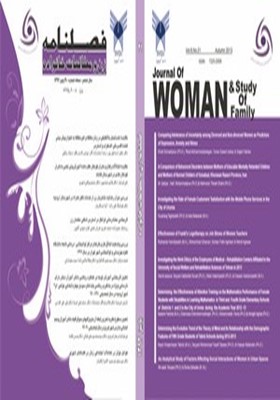تعیین سطوح نظریه ذهن و رابطه آن با ویژگی های دموگرافیک دانش آموزان پنجم ابتدائی مدارس شهر تبریزدر سال تحصیلی 92-91
محورهای موضوعی : زن و خانواده
کلید واژه: نظریه ذهن, روند تحولی نظریه ذهن, ویژگی های دموگرافیک,
چکیده مقاله :
در این پژوهش،سطوح نظریه ذهن در دانش آموزان پنجم ابتدایی و رابطه آن با برخی متغیرهای دموگرافیک(جمعیت شناختی) مانند ترتیب تولد فرزندان و تحصیلات والدین با نظریه ذهن بررسی شده است. برای این مطالعه 378 دانش آموز باروش نمونه گیری تصادفی خوشه ای از میان دانش آموزان دختر و پسر مدارس شهر تبریز انتخاب شدند.جهت اندازه گیری متغیر تحول نظریه ذهن از آزمون نظریه ذهن 38 سوالی استیرن من استفاده گردید. داده ها با استفاده از روش های آمار توصیفی، رگرسیون چند متغیره همزمان، آزمون تی دو گروه مستقل مورد تجزیه و تحلیل قرار گرفتند. روش این تحقیق از نوع توصیفی(غیر آزمایشی)همبستگی می باشد. یافته ها نشان داد نظریه ذهن در سطح دوم بین دختران و پسران متفاوت است و نیز بین میانگین نمرات آزمون نظریه ذهن دختران و پسران تفاوت معناداری وجود دارد.بررسی متغیرهای دموگرافیک نشان دادکه تحصیلات والدین پیش بینی کننده مثبت و معناداری در رابطه با نظریه ذهن و سطوح آن است ،ولی بین نظریه ذهن و ترتیب تولد فرزندان رابطه معناداری یافت نشد.
In this research, the evolution trend of the theory of mind in students of fifth grade and its relationship with some demographic variables including the order of children’s birth and parents’ education have been studied. To do this, 378 students have been selected by cluster randomized sampling from among male and female students of Tabriz schools and studied. In order to measure the variable of evolution of theory of mind, the 38- item, Steernman theory of mind test has been used. The data have been analyzed using descriptive statistics, multi-variate regression and independent t-test. The findings have shown that theory of mind on second level is different among boys and girls. Also, there is a significant relationship between mean scores of theory of mind test among boys and girls. Examination of demographic variables showed that parents’ education is a positive and significant predictor regarding the theory of mind and its levels, but between the theory of mind and the order of children’s birth, no significant relationship has been found.
- حسن زاده، سعید (1385)، «تحول شناختی کودکان ناشنوا بر اساس نظریه ذهن». رساله دکتری روانشناسی با گرایش کودکان استثنائی.دانشگاه تهران:دانشکده روانشناسی و علوم تربیتی.
- خانجانی، زینب. هداوندخانی، فاطمه (1388)، «نظریه ذهن: تحول و رویکردها». فصلنامه علمی-پژوهشی روانشناسی .دانشگاه تبریز.سال4،شماره16.ص119-89.
- غفاری، عذرا.بنی جمالی، شکوه السادات. احقر،قدسی (1389)،«بررسی تحول تئوری ذهن در دانش آموزان عادی و پرخاشگر دوره راهنمایی». تحقیقات روانشناختی. سال2، شماره7،7-18.
- قمرانی، امیر. البرزی، شهلا (1384)، « بررسی تحولی و مقایسه تئوری ذهن در کودکان عقب مانده ذهنی خفیف کودکان عادی سنین 7 تا 9 سال». پایان نامه کارشناسی ارشد روان شناسی کودکان استثنایی، شیراز: دانشگاه شیراز.
- قمرانی، امیر. البرزی،شهلا.خیر، محمد (1385)، «بررسی روایی و اعتبارآزمون نظریه ذهن در گروهی از دانش آموزان عقب مانده و عادی شهر شیراز».مجله روانشناسی 38.سال10،شماره2،ص181-199.
- محسنی، نیک چهره (1390)،«نظریه ها در روانشناسی رشد». تهران.انتشارات جاجرمی. ص457-476.
- مشهدی، علی و هاشمی، محبوبه(1390)،«نظریه ذهن و رابطه آن با مهارتهای اجتماعی در کودکان و نوجوانان مبتلا به آسیب بینایی».روانشناسی تحولی : روان شناسان ایرانی. سال هفتم.شماره27.ص219-230.
- منصوری، مریم وهمکاران (1389)، «مقایسه عوامل موثر بر تحول سطوح نظریه ذهن در کودکان مبتلابه اوتیسم وکودکان طبیعی».مجله علمی-پژوهشی دانشگاه علوم پزشکی اراک. سال 13،شماره 4. ص115-125.
- نسائیان،عباس. و عبداله زاده رافی،مهدی(1387)، « روانشناسی تحولی: نظریه ذهن». تهران: دانشگاه علوم بهزیستی و توان بخشی.
- Astington, Janet Wilde and Edward, Margaret.(2010),«The development of theory of mind in early childhood».Encyclopedia on early childhood development.
- Astington‚J.W.(1993),«The child’s discovery of the mind» .Cambridge MA:Harward University Press.
- Baron-C0hen S.(2000),«Theory of mind and autism»: A fifteen year review, In H. Tager- Flusberg, D. Cohen & S.Baron – Cohen (Eds.),Understanding other minds: Perspectives from autism and developmental cognitive neuroscience (pp.3-20). Oxford: Oxford.
- Dahlgren‚S.‚Sandberg‚A.D.‚&Larsson.M. (2010), «Theory of mind in children with severe speech and physical impairments». Research in Developmental Disabilities‚31(2),617-624
- Gregory‚C.‚Lough‚S.‚Stone‚V.E.‚Erzinclioglu‚S.‚Martin‚L.‚Baron-Cohen‚S.‚& hodges‚J.(2002),«Theory of mind in front-temporal dementia and Alzheimer’s disease:theoretical and practical implications».Brain‚125(4), 752- 764.
- Hale, C. & Tager-Flusberg, H .(2003), «The influence of language on theory of mind: A training study».Institutes National of Health; 6(3),346-359
- Jenkins,J. M., and Astigton, J. W.(1996), Cognitive Factors and Family Structure Associated with Theory of Mind Development in Young Children. Developmental psychology, 32(1),70-78
- Muris, P., Steerneman, P., Meesters, C., Merckelbach, H., Horselenberg, R., van den Hogen, T., & vanDongen, L. (1999), «The TOM test: A new instrument for assessing theory of mind in normalchildren and children with pervasive developmental disorders». Journal of Autism andDevelopmental Disorders, 29(1),67-80
- Flavell,J.H.,Miller,P.H&MillerS.A.(1993),«Cognitivedevelopmen». Englewood Cliffs, NJ: Prentice Hall.
- Steerneman,P.,Jackson,S.,Pelzer,H.,& Muris,P.(1999),«Children with social handicaps:An intervention program using a theory of mind approach».Clinical Child Psrchology and Psychiatry,1,251-263.

